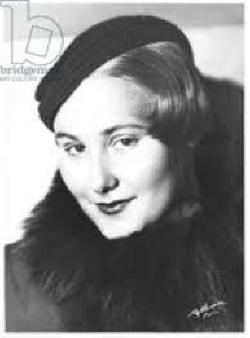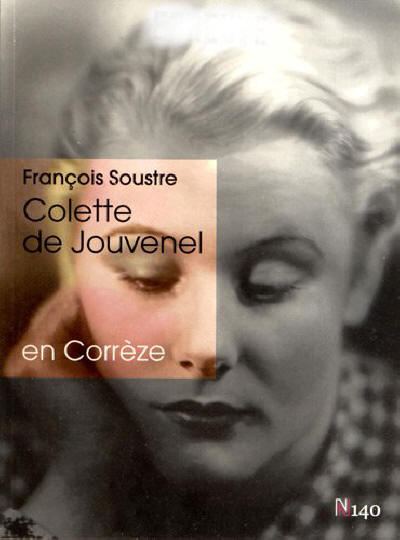Partner Nicole Stéphane
Queer Places:
Castel Novel, 19240 Varetz, France
Château de Saint-Hilaire, 19500 Curemonte, France
Cimetière du Père Lachaise
Paris, City of Paris, Île-de-France, France
 Colette de Jouvenel, also known as Bel-Gazou, (July 3, 1913 - September 16,
1981), was the daughter of French writer Colette and her second husband, Henri de Jouvenel. She was the half-sister of Renaud de Jouvenel and Bertrand de Jouvenel.
She had a relationship with Nicole Stéphane. When Colette came to realise that her own daughter, Bel-Gazou, was having
relationships with other women, she was strongly disapproving.
Colette de Jouvenel, also known as Bel-Gazou, (July 3, 1913 - September 16,
1981), was the daughter of French writer Colette and her second husband, Henri de Jouvenel. She was the half-sister of Renaud de Jouvenel and Bertrand de Jouvenel.
She had a relationship with Nicole Stéphane. When Colette came to realise that her own daughter, Bel-Gazou, was having
relationships with other women, she was strongly disapproving.
She spent, until the age of 9, a rather solitary childhood at the castle of
Castel-Novel, near Brive in Corrèze, raised by an English nurse, Miss Draper.
She will suffer greatly from the physical absence of her mother (who gave
birth to her at the age of 40 and very rarely visits her). At the beginning
of 1922, she returned to Paris where she entered, for a few months, the Lycée
Molière, before being placed, in October, as an intern, in a boarding school in
Saint-Germain-en-Laye, where her mother did not come to see her. During
her parents' divorce (1923), she was increasingly rebellious and failed at
school. In September 1926, she entered the fourth year at the Lycée Victor
Duruy in Versailles, whose director, weary of her poor results, finally
excluded her. In 1927, at the age of 14, she joined the girls' college on rue
du Four in Paris where she learned sewing, secretarial work and stenography,
before going on an apprenticeship in the fashion house Germaine Patat. But
she prefers independence, living in nature, swimming, dancing, drawing,
painting, listening to music or smoking in secret. At the age of 18, she
still has to build her own individuality and above all work.
In July
1931, she made her film debut, as assistant to director Solange Bussi for the
film La Vagabonde. Then Yves Mirande offered her to join Paramount. But society
did not want a female assistant at any price. Colette de Jouvenel will remember this discrimination. In 1933, she became assistant director of
Marc Allégret's film Lac aux dames (released in 1934). In 1935, she also assisted Max Ophüls with the film Divine. In May 1935, she left for Conakry, via Algeria and Côte d'Ivoire to know the life of the planters.
But on August 11, 1935, under family pressure, which probably found her too adventurous, she married a 32-year-old doctor, Camille Dausse, whom she left two months later and from whom she divorced in July 1936. This shock will be followed by a second, that of the death of her father, whom she felt close to, in October of the same year. She now
knew, too, that she preferred women and, until 1939, she will be an interior
designer.

The Second World War broke out and in June 40, Colette de Jouvenel moved to Corrèze, in the castle of Saint-Hilaire de Curemonte, another family castle. She quickly became close to the antifascists, including the Videau, a couple of teachers, and Berthe Vayssié who ran the village's café-bar-grocery store. It began by setting up an effective supply circuit, then participated more and more in resistance activities. She put herself at the service of the Children's Relief Work through her sister-in-law; the aim
was to protect children whose parents had been arrested or deported. In 1943, she met André Malraux, and his partner Josette Clotis, Emmanuel Berl and his wife Mireille,
a singer who can no longer work, because she was Jewish. She was in charge of specific missions in the ranks of the active opposition to the STO, and alongside the Corréziens, she helped children, refugees, Jews, resistance fighters or hunted down. Colette de Jouvenel lived two love stories during this period: first with Simy Wertheim, then with Jocelyne Alatini which allowed her to find a little joy in this turbulent period. In August 1944, she went to Oradour-sur-Glane, the village martyred two months earlier, and what she saw there would never cease to haunt her. At the beginning of October 1944, she was appointed president of the social and health committee of Brive, and, in January 1945, appointed deputy mayor of Curemonte.
Having become a Gaullist, the war gave her the desire to write and testify about
its ravages. In November 1944, her first article appeared in Femmes françaises, under the title "Travail urgent; social work". Juliette Jonvaux, director of the clandestine newspaper Fraternité (born under the Occupation), offered
her a place in the editorial staff. Her articles would make a big noise, including that of April 20, 1945 which evokes the shock of the arrival at the gare de Lyon of the survivors of Ravensbrück. Deeply affected by what she saw and heard, Colette de Jouvenel decided to go to Germany and — for three weeks — photographed, noted the testimonies, in order to give an account of Nazi barbarity.
Her report German Summer, appeared in Fraternité in several deliveries (during the summer of 1945). The report appears without the associated photographs, the publication management fearing, in fact, too big a shock of the images on its readers.
Her articles will however challenge several of them, including
Louis Aragon. She is now recognized
as a talented journalist and the public no longer sees her as only "the
daughter of... ».
Colette de Jouvenel, from October 1945, would use her pen in Fraternité to defend the equality of the sexes, demand a fairer status for women, as well as the promotion of women to positions of high responsibility. She also reported, again in Fraternité, on the debates of the International Congress of Women which
took place in Paris, from November 25 to December 1, 1945, at the Maison de la Mutualité.
In 1948, she resumed her work as a decorator and opened an antique shop on rue de Verneuil. Among her companions of the time, the actress and director
Nicole Stéphane, with whom she
would make a trip to Cuba.
When Colette died in August 1954, Colette de Jouvenel discovered that her mother had left a will that put her at a considerable disadvantage compared to Maurice Goudeket (Colette's third and last husband), who inherited, among other things, Colette's apartment at 9 rue de Beaujolais. Through
André Malraux, Colette de Jouvenel obtained that the small square in front of the Comédie-Française be baptized Place Colette, which was inaugurated on March 21, 1966.
She also launched the idea of creating the Cahiers Colette, the first issue of which (edited by the Société des Amis de Colette) was published in 1977.
When her father-in-law died the same year, she hoped to finally be able to recover her mother's apartment, to make it the museum she wished to dedicate to
her. But she died in September 1981, without having been able to do so. In an interview conducted towards the end of her life, to the question "what did it mean to you to have such a famous mother?" Colette de Jouvenel simply answered: "it takes a lifetime to recover. »
She is buried in Paris, in the Père-Lachaise cemetery (division 4), alongside her mother.
Colette's niece, Anne de Jouvenel, published in 2004, Colette : Lettres à sa fille - 1916-1953, on the occasion of the fiftieth anniversary of the writer's death.
My published books:


BBACK TO HOME PAGE
 Colette de Jouvenel, also known as Bel-Gazou, (July 3, 1913 - September 16,
1981), was the daughter of French writer Colette and her second husband, Henri de Jouvenel. She was the half-sister of Renaud de Jouvenel and Bertrand de Jouvenel.
She had a relationship with Nicole Stéphane. When Colette came to realise that her own daughter, Bel-Gazou, was having
relationships with other women, she was strongly disapproving.
Colette de Jouvenel, also known as Bel-Gazou, (July 3, 1913 - September 16,
1981), was the daughter of French writer Colette and her second husband, Henri de Jouvenel. She was the half-sister of Renaud de Jouvenel and Bertrand de Jouvenel.
She had a relationship with Nicole Stéphane. When Colette came to realise that her own daughter, Bel-Gazou, was having
relationships with other women, she was strongly disapproving.

